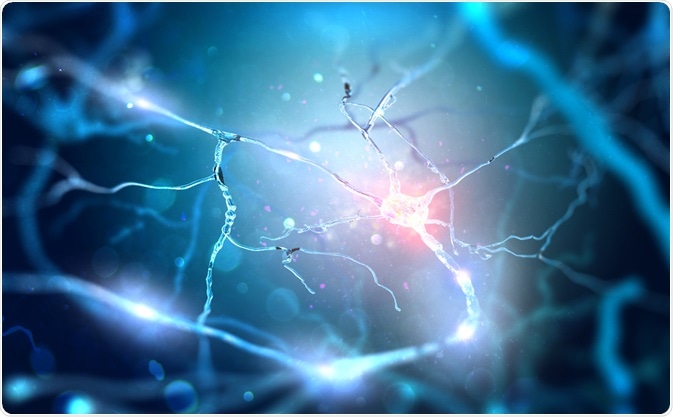Around the world, over 40 million people are living with human immunodeficiency virus type 1 (HIV-1) infections. In 2019 alone, it was estimated that around 690,000 of those infected with the virus died as a result of HIV-related illnesses.
 Image Credit: Andrii Vodolazhskyi / Shutterstock.com
Image Credit: Andrii Vodolazhskyi / Shutterstock.com
The World Health Organization (WHO) estimates that in total, since the beginning of the epidemic, roughly 33 million people have died of HIV/AIDS globally. Although there have been significant preventative efforts across the globe, the virus remains prevalent in society, having serious health implications for those infected.
Of these health implications, neurological complications are fairly commonplace, with over 20% of those with a diagnosis suffering some form of neurological condition as a result of the infection.
The collection of cognitive and motor dysfunctions associated with HIV infection is known as NeuroAIDS. This term encompasses an entire group of neurological disorders that are triggered by the damage that HIV does to both the central and peripheral nervous systems. Since the beginning of the HIV epidemic, health professionals have recognized the plethora of neurological complications that often go hand in hand with infection.
To date, the cause of NeuroAIDS has been well defined and is supported by a number of animal models. Currently, research is underway (both in vitro and in vivo) to investigate potential therapeutic avenues.
Manifestations of HIV/AIDS in the brain
Neuropathogensis of HIV-1 infection begins when the virus enters the central nervous system (CNS), directly and indirectly causing a range of neurological complications. AIDS dementia complex (ADC) is one of the most common neurological complications caused by HIV infection. Before highly active antiretroviral therapy (HAART) was developed, ADC was held accountable for a significant percentage of deaths in HIV-infected patients. Usually, this neurological manifestation of HIV infection is observed at the late stages of AIDS.
Around 30-60% of patients with HIV-1 infection present HIV-1-associated encephalitis (swelling of the brain caused by infection of the virus that causes problems with concentration and memory) during the late stages of AIDS. Additionally, 3-5% of patients present HIV-1-associated encephalitis as their only manifestation of HIV/AIDS in the brain.
Other common examples of neurological manifestations of HIV/AIDS include AIDS dementia, sensory neuropathy, and vacuolar myelopathy.
The biology of how HIV impacts the brain
A vast amount of research has been conducted which has revealed exactly how HIV infection can result in neurological complications. A number of studies have supported the hypothesis that microglia/macrophages act as cellular reservoirs for productive HIV-1 infection in the brain. Further to this, research has also demonstrated that the brain’s astrocytes can become infected by HIV-1 and that this infection can be detected by the presence of regulatory genes including nef and rev.
It has been found that interactions between the viral envelope and cellular receptors mediate HIV-1’s selectivity for different cell types. For example, the presence of cellular CD4 receptors determines HIV-1’s infection of monocytes/macrophages and T helper lymphocytes. Additionally, for HIV-1 to gain entry into target cells, members of the chemokine family of receptors are needed in addition to CD4 as coreceptors.
Research has also demonstrated that HIV-1 is able to infect non-CD4 expressing cells such as brain-derived glial and neuronal cells, colonic epithelial cells, fetal adrenal cells, follicular dendritic cells, human liver carcinoma cells, human skin fibroblasts, human trophoblasts, and muscle cells.
Additionally, HIV-1 cell tropism is determined by the V3 loop of gp120. It is hypothesized that this loop acts as a primary determinant for the infectivity of SK-N-MC cells, a CD4-negative galactosylceramide-positive neuroblastoma cell line. Altogether, the body of data strongly suggests that a cell of the nervous system’s susceptibility to infection by HIV-1, referred to as neurotropism, is the result of interactions between the viral epitopes (V3 loop) and receptors.
Future developments in prevention and detection
In spite of the significant developments that have been made over the recent decades in anti-retroviral therapies (ART), infection of HIV-1 remains to be a chronic disease across the world, even in developed countries. Research estimates that around 50% of those infected with the virus also have symptoms of cognitive impairment, highlighting the importance of furthering our knowledge of NeuroAIDS in order to develop accurate prevention and detection methods to improve the quality of life for patients with HIV-1 infection.
Recent research has focussed on exploring how biomarkers may be leveraged to develop methods of early detection of cognitive decline related to HIV-1 infection and to develop effective methods of prevention that can be administered before irreversible damage has been done. Scientists recently uncovered ATP as a potential biomarker, with studies showing that circulating levels of the biomarker are correlated with levels of cognitive decline in patients infected with HIV-1.
Future studies will likely follow up on this breakthrough in an attempt to develop new therapies for preventing Neuro/AIDS.
Sources
Ances, B., 2008. Emerging views of NeuroAIDS. The Lancet Neurology, 7(7), p.580. www.thelancet.com/.../fulltext
Eggers, C., Arendt, G., Hahn, K., Husstedt, I., Maschke, M., Neuen-Jacob, E., Obermann, M., Rosenkranz, T., Schielke, E. and Straube, E., 2017. HIV-1-associated neurocognitive disorder: epidemiology, pathogenesis, diagnosis, and treatment. Journal of Neurology, 264(8), pp.1715-1727. https://www.ncbi.nlm.nih.gov/pmc/articles/PMC5533849/
Global Health Observatory (GHO) data: HIV/AIDS. World Health Organization. Available at: https://www.who.int/gho/hiv/en/
Shapshak, P., Kangueane, P., Fujimura, R., Commins, D., Chiappelli, F., Singer, E., Levine, A., Minagar, A., Novembre, F., Somboonwit, C., Nath, A. and Sinnott, J., 2011. Editorial NeuroAIDS review. AIDS, 25(2), pp.123-141. https://www.ncbi.nlm.nih.gov/pmc/articles/PMC4464840/
TRUJILLO, J., JARAMILLO-RANGEL, G., ORTEGA-MARTINEZ, M., PENALVA de OLIVEIRA, A., VIDAL, J., BRYANT, J. and GALLO, R., 2005. International NeuroAIDS: prospects of HIV-1 associated neurological complications. Cell Research, 15(11-12), pp.962-969. https://www.nature.com/articles/7290374
Velasquez, S., Prevedel, L., Valdebenito, S., Gorska, A., Golovko, M., Khan, N., Geiger, J. and Eugenin, E., 2020. Circulating levels of ATP is a biomarker of HIV cognitive impairment. EBioMedicine, 51, p.102503. https://www.sciencedirect.com/science/article/pii/S2352396419306929
Further Reading